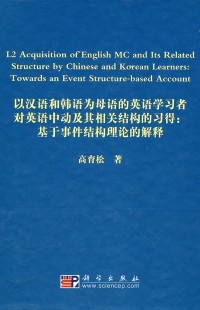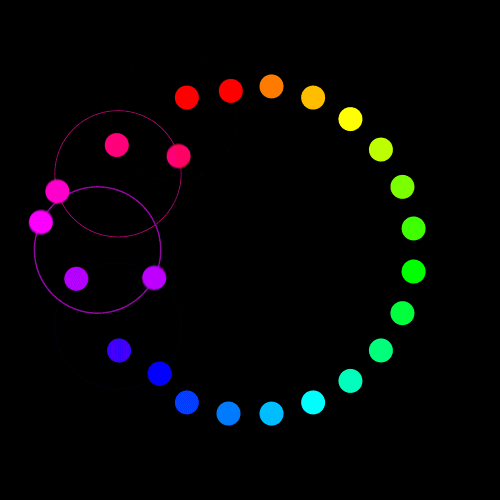
L2 acquisition of English MC and its related structure by Chinese and Korean learners: towards an event structure-based account
副标题:无
作 者:高育松著
分类号:
ISBN:9787030292032
微信扫一扫,移动浏览光盘
简介
《以汉语和韩语为母语的英语学习者对英语中动及其相关结构的习得·基于事件结构理论的解释》旨在探讨以汉语和韩语为母语的英语学习者如何习得英语中动及其他去及物结构。研究以Pusteiovsky(1990a,1990b,1996)扩展的事件结构理论(EEST)为理论框架。鉴于该理论没有细化(复杂)事件分解为子事件的条件,尚不能充分解释英语去及物结构,本研究对EEST做了进一步修正,提出了(复杂)事件分解为子事件的三个条件,即“子事件独立表达条件”、“事件参与者表达条件”和“子事件-结构性事件参与者-致条件”。
目录
前言
preface
acknowledgements
chapter 1 introduction
1.1 research orientation
1.2 middle construction: object of research
1.2.1 delimiting the research scope
1.2.2 major properties of the middle construction
1.2.3 mc and its related structures in english
1.3 research rationale
1.4 key research questions
1.5 contents of remaining chapters
chapter 2 review of the related literature: theoretical accounts of english middle construction
2.1 introduction
2.2 theoretical accounts of mc
2.2.1 the generative account
2.2.2 the cognitive account
2.2.3 semantics-syntax interface account
2.3 a critique of the theoretical account of english mc
2.4 summary
.chapter 3 conceptual framework: a revised extended event structure theory
3.1 introduction
3.2 pustejovsky\'s extended event structure (1991a, 1991b, 1996)
3.2.1 an overview
3.2.2 extended event structure
3.2.3 qualia structure
3.2.4 cross-reference of event structure to qualia structure
3.3 a revised version of pustejovsky\'s extended event structure theory
3.3.1 weaknesses of eest
3.3.2 a revision of eest
3.4 summary
chapter 4 an analysis of english mc and its related structures within the framework of the revised eest
4.1 introduction
4.2 semantic constraints upon english mc
4.2.1 event type-related constraint: headedness constraint
4.2.2 event role-related constraint: inherent property foregrounding constraint
4.2.3 event modification-related constraint: event focus agreement constraint
4.2.4 conceptually-related constraint: event autonomy constraint
4.2.5 summary: constraints upon mc and other detransitivized structures
4.3 chinese mc formation
4.3.1 chinese mc: an overview
4.3.2 constraints upon chinese mc
4.3.3 mc-related structures in korean
4.4 canonical event structure, its extension and mc formation
4.5 general summary
chapter 5 l2 acquisition of english mc and its related structures
5.1 introduction
5.2 transitivity errors committed by l2 learners of english
5.3 theoretical accounts of l2 acquisition of transitivity
5.3.1 theoretical accounts of l2 acquisition of causative alternation
5.3.2 theoretical accounts of l2 passivization of unaccusatives
5.4 a critique of current accounts of l2 acquisition of causative alternation and passivization of unaccusativity
5.5 zoom lens hypothesis and its implication for the present study
5.6 l2 acquisition of english detransitivization: a theoretical framework and research hypotheses
5.6.1 a theoretical framework for l2 acquisition of english detransitivization
5.6.2 route of l2 acquisition of english mc and its related structures and research hypotheses
5.7 summary
chapter 6 research design, instrumentation, data collection and data analysis
6.1 research design
6.2 participants
6.3 instrumentation
6.3.1 acceptability judgment task (ajt)
6.3.2 forced-choice task (fct)
6.3.3 guided translation task (gtt)
6.3.4 error correction task (ect)
6.3.5 follow-up interview task (fit)
6.4 task assignment
6.5 data collection procedures
6.6 data coding and scoring
6.6.1 coding and scoring gtt data
6.6.2 scoring of ajt data
6.6.3 scoring of fct data
6.6.4 coding and scoring of ect data
6.6.5 coding of fit data
6.7 data analysis
6.8 summary
chapter 7 results for research hypotheses testing
7.1 results for hypothesis 1
7.1.1 testing hypothesis i through gtt
7.1.2 testing hypothesis 1 through fct
7.1.3 testing hypothesis i through ajt
7.1.4 testing hypothesis i through the fit
7.2 results for hypothesis 2
7.2.1 testing hypothesis 2 through fct
7.2.2 testing hypothesis 2 through ajt
7.3 results for hypothesis 3
7.3.1 testing hypothesis 3 through ajt
7.3.2 testing hypothesis 3 through gtt
7.4 results for hypothesis 4
7.4.1 testing hypothesis 4 through ajt
7.4.2 testing hypothesis 4 through fit
7.5 results for hypothesis 5
7.6 results for hypothesis 6
7.6.1 testing hypothesis 6 through fct
7.6.2 testing hypothesis 6 through fit
7.7 results for hypothesis 7
7.8 summary
chapter 8 general discussion
8.1 major findings
8.1.1 linguistic findings
8.1.2 empirical findings
8.1.3 developmental route of l2 acquisition of english mcs and its related structures
8.2 an overall assessment of the adopted theoretical framework
8.2.1 an assessment of default event template hypothesis
8.2.2 an assessment of the event structure approach
8.2.3 an assessment of the modular view of l1 transfer
8.2.4 summary
8.3 l1-mediated default event template hypothesis
8.3.1 introduction
8.3.2 agency extension and degree of acceptance of mc and ac
8.3.3 language distance and transfer of l1 morphology
8.3.4 interaction between universal language properties and specific language constraints
8.3.5 summary
8.4 an alternative account
8.5 general summary: a unified account of l2 acquisition of detransitivization
chapter 9 conclusions, pedagogical implications, limitations, and suggestions for further research
9.1 conclusions
9.1.1 summary of the present study
9.1.2 conclusions
9.2 implications for l2 instruction
9.3 limitations and suggestions for further research
references
appendix descriptive statistic data for the figures
preface
acknowledgements
chapter 1 introduction
1.1 research orientation
1.2 middle construction: object of research
1.2.1 delimiting the research scope
1.2.2 major properties of the middle construction
1.2.3 mc and its related structures in english
1.3 research rationale
1.4 key research questions
1.5 contents of remaining chapters
chapter 2 review of the related literature: theoretical accounts of english middle construction
2.1 introduction
2.2 theoretical accounts of mc
2.2.1 the generative account
2.2.2 the cognitive account
2.2.3 semantics-syntax interface account
2.3 a critique of the theoretical account of english mc
2.4 summary
.chapter 3 conceptual framework: a revised extended event structure theory
3.1 introduction
3.2 pustejovsky\'s extended event structure (1991a, 1991b, 1996)
3.2.1 an overview
3.2.2 extended event structure
3.2.3 qualia structure
3.2.4 cross-reference of event structure to qualia structure
3.3 a revised version of pustejovsky\'s extended event structure theory
3.3.1 weaknesses of eest
3.3.2 a revision of eest
3.4 summary
chapter 4 an analysis of english mc and its related structures within the framework of the revised eest
4.1 introduction
4.2 semantic constraints upon english mc
4.2.1 event type-related constraint: headedness constraint
4.2.2 event role-related constraint: inherent property foregrounding constraint
4.2.3 event modification-related constraint: event focus agreement constraint
4.2.4 conceptually-related constraint: event autonomy constraint
4.2.5 summary: constraints upon mc and other detransitivized structures
4.3 chinese mc formation
4.3.1 chinese mc: an overview
4.3.2 constraints upon chinese mc
4.3.3 mc-related structures in korean
4.4 canonical event structure, its extension and mc formation
4.5 general summary
chapter 5 l2 acquisition of english mc and its related structures
5.1 introduction
5.2 transitivity errors committed by l2 learners of english
5.3 theoretical accounts of l2 acquisition of transitivity
5.3.1 theoretical accounts of l2 acquisition of causative alternation
5.3.2 theoretical accounts of l2 passivization of unaccusatives
5.4 a critique of current accounts of l2 acquisition of causative alternation and passivization of unaccusativity
5.5 zoom lens hypothesis and its implication for the present study
5.6 l2 acquisition of english detransitivization: a theoretical framework and research hypotheses
5.6.1 a theoretical framework for l2 acquisition of english detransitivization
5.6.2 route of l2 acquisition of english mc and its related structures and research hypotheses
5.7 summary
chapter 6 research design, instrumentation, data collection and data analysis
6.1 research design
6.2 participants
6.3 instrumentation
6.3.1 acceptability judgment task (ajt)
6.3.2 forced-choice task (fct)
6.3.3 guided translation task (gtt)
6.3.4 error correction task (ect)
6.3.5 follow-up interview task (fit)
6.4 task assignment
6.5 data collection procedures
6.6 data coding and scoring
6.6.1 coding and scoring gtt data
6.6.2 scoring of ajt data
6.6.3 scoring of fct data
6.6.4 coding and scoring of ect data
6.6.5 coding of fit data
6.7 data analysis
6.8 summary
chapter 7 results for research hypotheses testing
7.1 results for hypothesis 1
7.1.1 testing hypothesis i through gtt
7.1.2 testing hypothesis 1 through fct
7.1.3 testing hypothesis i through ajt
7.1.4 testing hypothesis i through the fit
7.2 results for hypothesis 2
7.2.1 testing hypothesis 2 through fct
7.2.2 testing hypothesis 2 through ajt
7.3 results for hypothesis 3
7.3.1 testing hypothesis 3 through ajt
7.3.2 testing hypothesis 3 through gtt
7.4 results for hypothesis 4
7.4.1 testing hypothesis 4 through ajt
7.4.2 testing hypothesis 4 through fit
7.5 results for hypothesis 5
7.6 results for hypothesis 6
7.6.1 testing hypothesis 6 through fct
7.6.2 testing hypothesis 6 through fit
7.7 results for hypothesis 7
7.8 summary
chapter 8 general discussion
8.1 major findings
8.1.1 linguistic findings
8.1.2 empirical findings
8.1.3 developmental route of l2 acquisition of english mcs and its related structures
8.2 an overall assessment of the adopted theoretical framework
8.2.1 an assessment of default event template hypothesis
8.2.2 an assessment of the event structure approach
8.2.3 an assessment of the modular view of l1 transfer
8.2.4 summary
8.3 l1-mediated default event template hypothesis
8.3.1 introduction
8.3.2 agency extension and degree of acceptance of mc and ac
8.3.3 language distance and transfer of l1 morphology
8.3.4 interaction between universal language properties and specific language constraints
8.3.5 summary
8.4 an alternative account
8.5 general summary: a unified account of l2 acquisition of detransitivization
chapter 9 conclusions, pedagogical implications, limitations, and suggestions for further research
9.1 conclusions
9.1.1 summary of the present study
9.1.2 conclusions
9.2 implications for l2 instruction
9.3 limitations and suggestions for further research
references
appendix descriptive statistic data for the figures
L2 acquisition of English MC and its related structure by Chinese and Korean learners: towards an event structure-based account
- 名称
- 类型
- 大小
光盘服务联系方式: 020-38250260 客服QQ:4006604884
云图客服:
用户发送的提问,这种方式就需要有位在线客服来回答用户的问题,这种 就属于对话式的,问题是这种提问是否需要用户登录才能提问
Video Player
×
Audio Player
×
pdf Player
×


